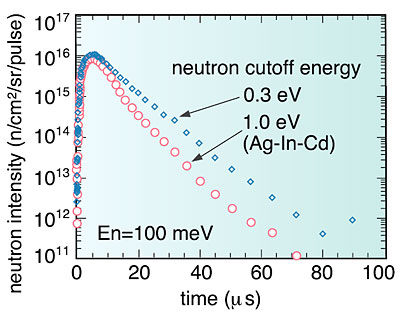In a pulsed spallation neutron source, neutrons are generated in the target by a spallation reaction resulting from incident pulsed protons. The generated neutrons, which pass through the moderator, are slowed to produce a neutron beam with appropriate energy. A thermal neutron absorber material, called a decoupler, is used to obtain pulsed neutron beams with a short decay time because it absorbs the low energy neutrons entering the moderator, which would otherwise result in long decay times. Higher cutoff energy of the decoupler gives shorter decay time (Fig. 4-1). The short decay time reduces a background noise in a neutron scattering experiment (Fig. 4-2). The decoupler is indispensable for high-resolution experiments. The boron-based material, such as boron carbide (B4C) has already been utilized for a decoupler system; however, it is not suitable for a MW-class neutron source due to helium void swelling and local heating by (n, alpha) reactions.
A new decoupler material was developed that eliminates the (n, alpha) reactions. This decoupler consists of elements having different resonance absorption energies. These elements, combined in a silver-indium-cadmium (Ag-In-Cd) alloy. Its macroscopic neutron cross-section has an energy-dependence like B4C. However, it had to be bonded between pieces of aluminum (Al) alloy. The structural material of the moderator is an Al alloy, and the bonding was necessary to provide corrosion protection from the cooling water and for heat removal. It is generally difficult to obtain a good bond between Ag-In-Cd alloy and Al alloy due to the low melting point of the Al alloy. The hot isostatic pressing (HIP) technique was adopted to solve this problem. To obtain a good bond, experiments were performed under parametric conditions of pressure, temperature, holding time, and surface treatment. Mechanical tests (mainly, tensile strength tests) were also performed to evaluate mechanical strength. The optimal bonding conditions were found to be a pressure of 100 MPa, a temperature of 803K, and a holding time of at least 10 minutes. This was the first successful application of a bonding material having the required mechanical design strength (Fig. 4-3).
|


